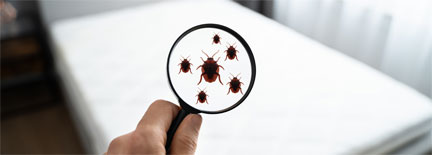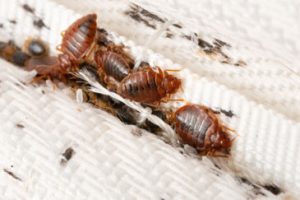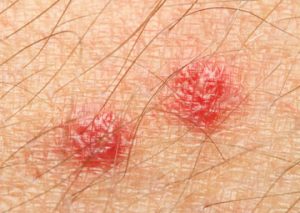If you’re worried about a bed bug infestation in your home, a thorough bed bug inspection is crucial. Bed bugs can be found not only in hotels, public transit, or movie theaters but also in apartments, homes, work facilities, schools, stores, and just about anywhere humans gather together. According to the “Bugs without Borders” study, pest control workers report treating bed bug infestations in single-family homes and apartments, as well as other common areas like movie theaters, laundry facilities, transportation units, and college dormitories.
To get rid of bed bugs, you need to know how to look for them. Due to their survival instinct, bed bugs can hide just about anywhere. In most cases, you’ll find them close to where you sleep or spend most of your time sitting. So start your bed bug inspection around sleeping areas, such as your mattress and box spring, behind your headboard and nightstands. Keep in mind that they can also be found in baseboards, behind electrical switch plates, in picture frames, behind wallpaper, or even in books.
The best time to search for bed bugs is at night since they tend to sleep during the daytime. They’ll sneak into your mattress or box springs, and they can also be found in baseboards, behind electrical switch plates, in picture frames, behind wallpaper, or even in books.
Bed bugs are pesky insects that can infest your home, and it is important to know how to inspect for them and get rid of them if they are found. The first step in the process is a thorough bed bug inspection to identify any signs of an infestation. Here’s how to look for bed bugs and where to find them.
- Check Your Mattress and Box Spring The mattress and box spring are common hiding places for bed bugs. To inspect for them, remove all bedding and check the seams, folds, and crevices of the mattress and box spring. Look for any signs of bed bugs, including the bugs themselves, small black or brown spots (fecal matter), and shed skins.
- Look in Other Furniture Bed bugs can also hide in other furniture, such as couches, chairs, and dressers. Inspect these items carefully, paying close attention to any crevices or seams. Look for the same signs of bed bugs, including bugs, fecal matter, and shed skins.
- Inspect Carpet and Baseboards Bed bugs can also hide in carpet fibers and behind baseboards. To inspect for them, check along the edges of the carpet and behind baseboards for signs of bed bugs. Look for the same signs as before, including bugs, fecal matter, and shed skins.
- Check Electrical Outlets and Wall Switches Bed bugs can also hide behind electrical outlets and wall switches. Remove the cover plates and inspect these areas carefully.
- Look in Luggage and Clothing If you have recently traveled or have had guests stay in your home, check your luggage and clothing for bed bugs. These insects can hitch a ride on clothing and luggage, and infest your home.
If you suspect a bed bug infestation, the next step is to get rid of bed bugs. If you have bed bugs, it’s best to call a professional exterminator to take care of the problem. With DIY Bed Bug Heaters, in the Colorado Springs area, you can have your home professionally inspected for bed bugs, and you can easily take care of your bedbug problem with our affordable do-it-yourself bed bug heat treatment.




